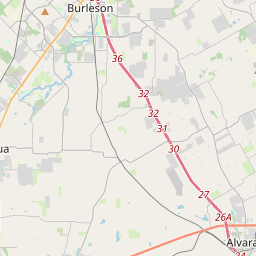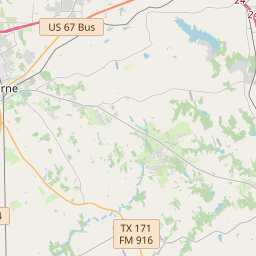Balch-Senterwood Cemetery
Historical marker location:












This graveyard was established in 1856 adjacent to the Balch Cemetery for the African American population following the death of a slave girl killed by a black bear. The girl had come to Alvarado with George Sigler and his family, whose farm was located south of the Balch Community Cemetery. Among those buried here are victims of an epidemic of smallpox, and other diseases such as diphtheria, whooping cough, and tuberculosis. Casualties included numerous children. The need for burial space became acute by 1911 following these disease-related deaths. A. J. Senter, local businessman and undertaker, donated additional land to the Alvarado "Colored" Cemetery in 1911. The site was renamed Senterwood Cemetery in his honor. The need for more burial plots in the 1940s was resolved through the purchase of one acre of land by the Baker Funeral Home of Fort Worth. Interments in this cemetery include many business owners, church leaders, and veterans of World War I, World War II, and the Vietnam War. Cemetery maintenance, previously dependent upon local volunteers, was performed under the direction of the Johnson County Cemetery Association. The Balch-Senterwood Cemetery continues to serve the surrounding communities.
(1996)
As one of the most visible programs of the Texas Historical Commission (THC), historical markers commemorate diverse topics in Texas history, including: the history and architecture of houses, commercial and public buildings, religious congregations, and military sites; events that changed the course of local and state history; and individuals who have made lasting contributions to the state, community organizations, and businesses.
The state of Texas was once an independent country known as the Republic of Texas. It gained independence from Mexico in 1836 and was a separate nation until it was annexed by the United States in 1845.
The establishment of Johnson County can be traced back to 1854 when it was officially organized and named after Middleton Tate Johnson, a Texas Ranger and a Confederate commander during the Civil War. The county quickly began to grow, attracting settlers from nearby areas due to its abundant natural resources and favorable climate for agriculture. Cotton and corn became the primary crops, and the county's economy thrived, aided by the construction of railroads in the late 1800s.
Throughout its history, Johnson County has faced both triumphs and challenges. In the late 1800s, the county was known for its fertile soil and large cotton plantations, which contributed to its economic prosperity. However, like many areas in the South, Johnson County also experienced the hardships of Reconstruction following the Civil War. Additionally, the destructive effects of the Great Depression in the 1930s had a significant impact on the local economy, causing widespread poverty and unemployment.
In recent decades, Johnson County has seen significant growth and development. With an expanding population and a diverse economy, the county has become a hub for industry, commerce, and residential communities. Today, it continues to embrace its rich cultural heritage while adapting to the changing needs of its residents. Johnson County's historical legacy serves as a reminder of the resilience and determination of its people, allowing the county to thrive and face the future with confidence.
Johnson County Timeline
This timeline provides a glimpse into the major events and milestones that have shaped the history of Johnson County, Texas.
- 1846: Johnson County is established as a county in the state of Texas.
- 1861-1865: Johnson County sends soldiers to fight in the American Civil War.
- 1867: The county experiences economic growth as the Chisholm Trail passes through, bringing cattle drives and trade.
- 1879: The town of Cleburne is established as the county seat.
- 1880s: The arrival of the railroad boosts the local economy and facilitates transportation.
- 1893: The Johnson County Courthouse is constructed in Cleburne, becoming a local landmark.
- 1920s: The county suffers from the Great Depression, causing economic hardships for its residents.
- 1940s: Johnson County contributes to the war effort during World War II, with many residents serving in the military.
- 1950s-1960s: The county experiences population growth and suburbanization.
- 1990s: The opening of the Chisholm Trail Parkway provides improved transportation and connectivity.